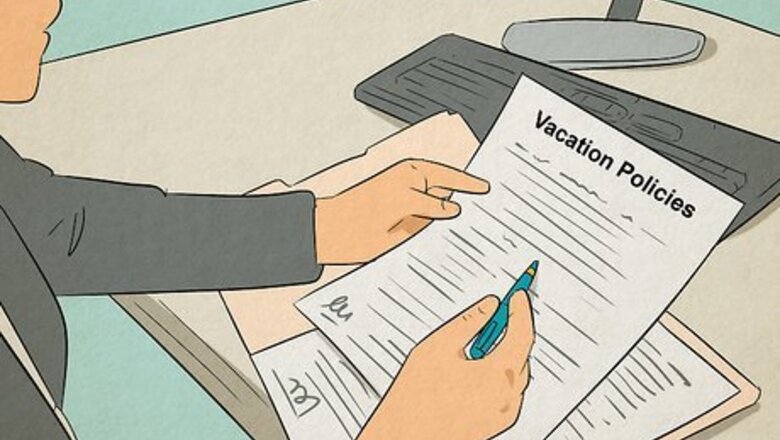
views
- Make sure your company's policy doesn't prevent you from taking off on certain days or during specific weeks.
- When you send an email, include the days off in the subject line so your supervisor can see the dates easily.
- Send your email at least 2 weeks in advance so you're not suddenly springing your PTO on your coworkers.
Asking for Time Off
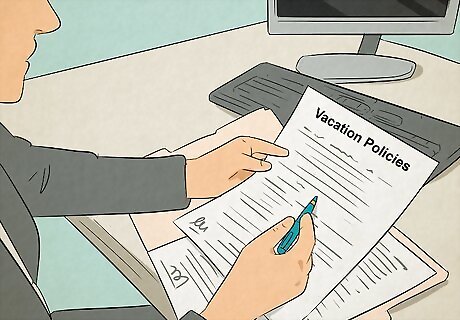
Check your company's policies on requesting time off work. Check your employee handbook or ask a supervisor what the vacation policy is at your workplace. Figure out how many days you have available, how and when they accrue, and if you are eligible for paid time off. Seniority might also affect how many days you can take off and when you can take a vacation. If you are a new employee, check to see if you are eligible for time off yet. Taking time off when you are a new employee can be difficult, and your supervisor might not be enthusiastic.
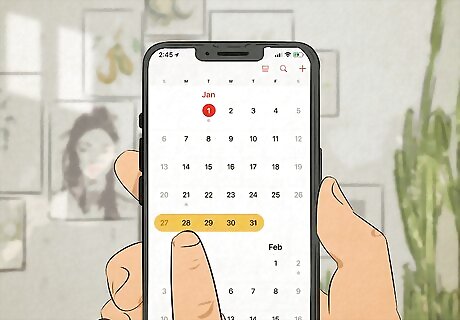
Plan your days off at a convenient time. It will be easier to take time off if you are not involved in an ongoing project, or if there are no impending deadlines. If your company has a certain time of the year that is very busy, you should try to avoid taking days off work during that period. If you need time off during a busy period for an unexpected emergency or opportunity, provide a strong explanation for your request. If possible, ask if anyone else is considering taking time off around the dates you want. If your place of employment is short-staffed, it will be harder for your supervisor to grant your request. If your request for time off is granted, remind your coworkers that you will be gone about a week before you take your time off work.
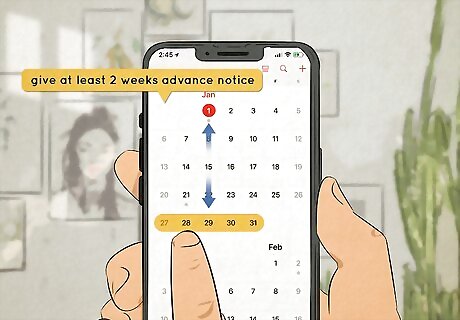
Make your request at least 2 weeks in advance. You should ask for days off at least 2 weeks before the date you want to start your time off. Generally, the more advance notice you are able to provide, the better the chances you have of getting the time off. Letting your supervisor know that you plan on taking time off several weeks, or even a month before you plan on leaving will allow your workplace to prepare for your absence. The longer you plan on taking off work, the more advance notice you should provide. Giving 2 weeks' notice for a few days off is sufficient. If you will be gone for a week or more, you should try to let your boss know at least 1 month before you plan to leave.

Complete as much work as you can before you leave. If there are tasks and responsibilities that you would do during the time you are requesting off work, complete as many of them as you can before you leave. Assuring your coworkers that your absence will not overly burden them will be greatly appreciated and make it easier for your supervisor to grant your request. If you have work responsibilities that cannot be completed before you leave, make arrangements with coworkers to cover for you. Be sure that they fully understand the tasks you need them to accomplish. Provide them with contact information in case they need your help.
Tips for Writing the Email
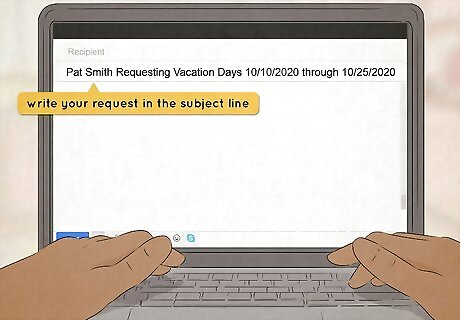
Put your request in the email subject line. You want your supervisor to immediately understand your request without even opening the email. Specifically, state that you are requesting time off, and provide the dates you are requesting in the subject line. For example, a subject line could be: "Pat Smith Requesting Vacation Days 10/10/2020 through 10/25/2020."
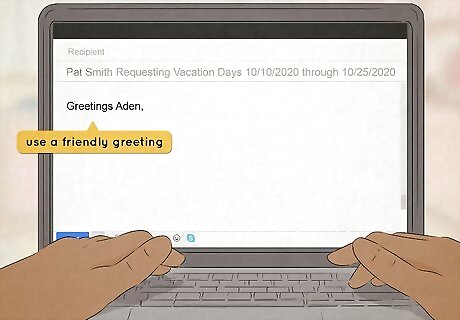
Open with a friendly greeting. Address your supervisor directly by name and include a salutation. It may seem like an unnecessary or unimportant thing, but sets a warm tone and makes the email look more professional. Your greeting doesn’t need to be anything fancy. Saying something as simple as “Hey Jane”, “Hello Dave”, or “Greetings Aden” is perfectly fine. Be aware of your supervisor's titles and preferences for how they are addressed. If your place of employment typically uses last names in communication, using your supervisor’s first name in an email might seem disrespectful. Similarly, if your supervisor uses a title prefix (like doctor, professor, judge, etc.), you should use it in your greeting.
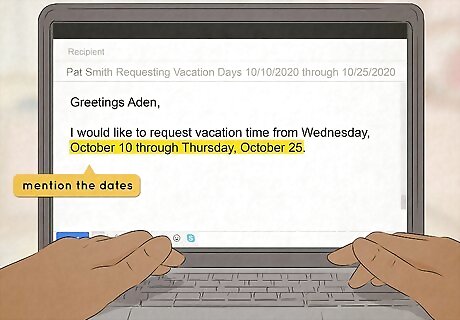
Provide the dates you want to take off. Even though you have already put the dates you want off in the email subject line, you should restate them in the first line of your email. Put this information in the form of a request. For example, you could write: “I would like to request vacation time from Wednesday, October 10 through Thursday, October 25."
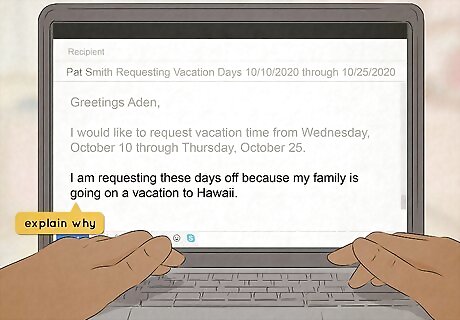
Explain why you want time off. Immediately after you give the dates that you want off, provide the reason you are making the request. You should be honest about why you want the time off, even if you think your reason won't get a positive reply. If you lie about why you need time off there could be severe repercussions, and it will be much harder to request time off in the future. For example, you might write: "I am requesting these days off because my family is going on a vacation to Hawaii." If you are requesting time off because of an emergency or an unexpected event, make sure you emphasize this in your explanation. Funerals, medical issues, or even surprise weddings are some examples of unexpected events that would make your supervisor more likely to grant a last-minute request.
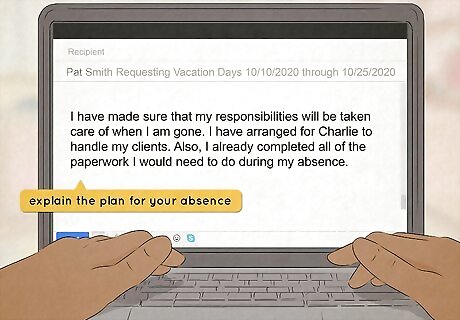
Reassure your supervisor that you have a plan for your absence. Let your employer know that you have carefully considered how your absence might affect the workplace. If you need to make arrangements for someone to cover for you or if existing projects and clients might need your attention during your time off, explain the details of how you will solve these issues. The more work and frustration you can save your supervisor, the more comfortable they will be with you taking the time off. For example, you could write: "I have made sure that my responsibilities will be taken care of when I am gone. I have arranged for Charlie to handle my clients. Also, I already completed all of the paperwork I would need to do during my absence." It is always a good idea to tell your supervisor how you can be contacted while you are away. If you are unable, or unwilling, to provide a phone number or email where you can be reached during your time off, you will need to state this information in your request.
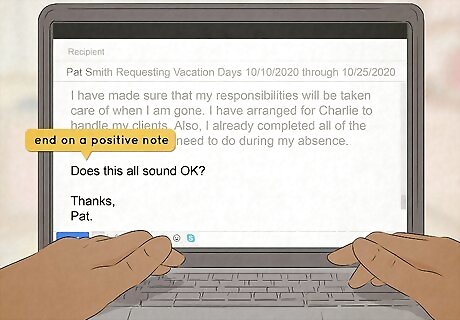
End on a positive note. The last line of your email should ask if the request you have laid out is fine with your employer. You should also thank your supervisor before signing off with your name. This maintains the friendly and professional tone that started with your greeting. For example, the closing part of your email might read: “Does this all sound OK? Thanks, Pat.”




















Comments
0 comment